Last Updated on August 29, 2017 by Marc Seward
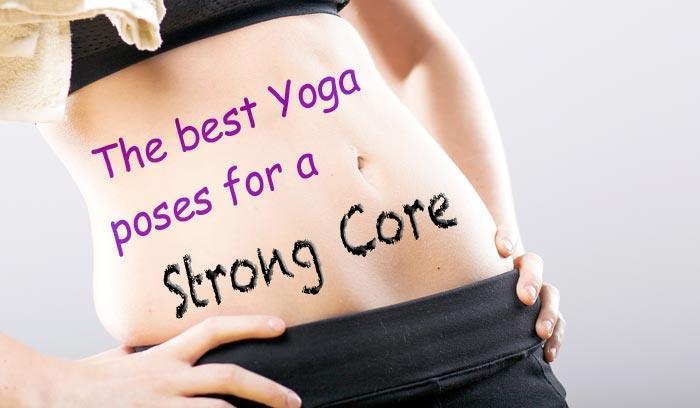
You have seen the ads for a “stronger core” and pictures of six-pack abs. Who does not want a flat stomach? However, building a strong core is more than just for looks. Sure, we all want a trim and flat stomach but having a strong and functional core is beyond skin deep. Of course having that flat stomach is a pretty nice benefit.
What is your core—isn’t that just your abs?
Your “core” is more than just your midsection. A strong core is not just doing a bunch of sit-ups. It is a collection of functional muscles including:
- Abdominals-are key for posture, breathing, and protecting internal organs. There is more too them than just the “six-pack” portion.
- Multifidus (a small but powerful muscle that gives support to your spine)
- Pelvic Floor (muscles and ligaments that support the bladder, rectum and sexual organs)
- Diaphragm—Muscles and tendons that are used in breathing.Most people do not get enough targeted movements to keep these muscles in shape. In our modern workplace, we spend too much time sitting and the muscles in the core become weak and out of balance. Unless you have a physical job you likely will need a routine to strengthen the muscles in your core are.
A strong core is critical for many functional reasons. Working your core helps you to avoid injuries and to perform better in yoga and sports. A stronger core also helps with the following:
- Improves balance and stability
- Building a strong core also lessens chances for back pain. The root cause of most back pain is actually muscle imbalances between the abdominals and back muscles. Studies have shown that core strength not only helps improve stability and coordination but also helps to prevent lower back injuries. (1)
- Core training can actually even help improve knee function. Recent studies have shown that core stability and strength programs can help improve knee joint functioning. (2)
- You will perform everyday tasks that typically task your “back” much better. Tasks that require stooping, bending will be easier and less painful.
- A strong core will help improve your Posture. Slouching and poor posture are often caused by weak and imbalanced muscles.
As you can see, there are many proven benefits to a stronger core. It is also a basis for getting better at many sports activities. Core stability and strength have proven performance benefits (3)
Why Yoga for a Stronger Core?
The diversity and complexity of these muscles is why yoga is so critical in building up strength. Holding poses, controlling breathing and performing deliberate and targeted movements to hit these areas are harder doing just traditional exercises.
Most of these muscles cannot be addressed solely by increasing weight—they need specific targeting in order to be isolated.
Below are some suggested poses and movement exercises.
Yoga for strong core
These exercises are setup to flow” in this order. The poses could be done in any order but they flow well from one position to the next.
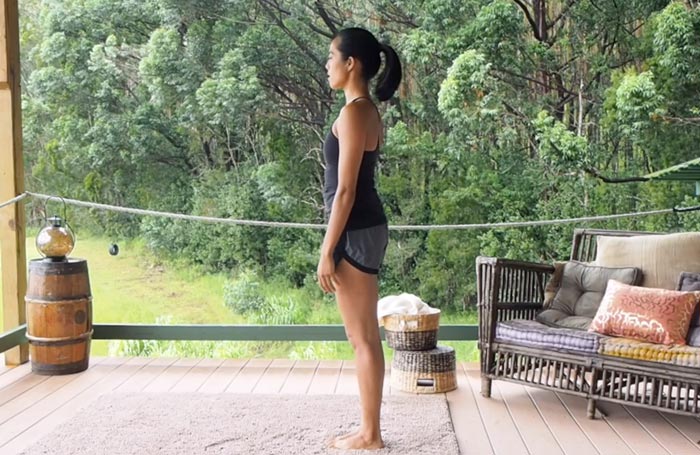
Click here to see VIDEO of the specific exercise.
Mountain Pose
- For Mountain pose, stand with feet together, hands relaxed at your side.
- Focus on bringing the weight of your body between the balls of your feet and your heels
- Try and pull your torso up and hips in, while pushing shoulders back—keeping posture nice and straight.
- Look forward in a neutral position with your chest upright.
- Take deep breaths, focus on keeping your spine aligned and getting your mind clear.
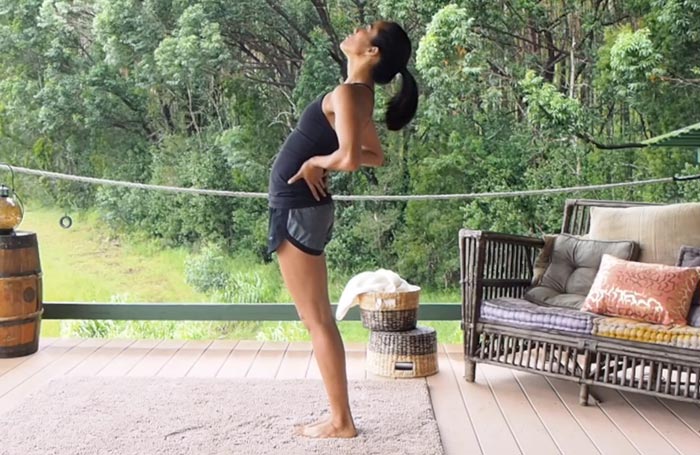
Click here to see VIDEO of the specific exercise.
Standing back bend
- Place both hands at the lower back where it meets the top of your glutes.
- With your feet together, firmly on the ground-keep your weight evenly distributed and push your hips forward.
- Begin to arch back, inhaling as you go back looking up towards the sky. It is important to maintain a tight core, exhale as your come up. If you want to deepen the move—you can depending on your flexibility. Make sure you support your back and are completely comfortable in this pose. Do not do anything if you feel any sharp pain or extreme discomfort or if it simply does not “feel” right.
- After the standing back bend, you can move to the next pose:
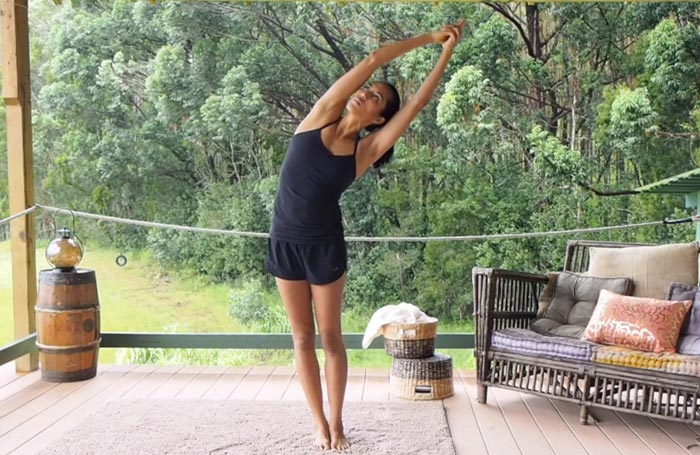
Click here to see VIDEO of the specific exercise.
Half Moon
- Move Forward from the standing back bend to a half moon pose.
- Put your feet together and raise your arms up over your head with a nice inhale.
- At the top clasp both hands together, keeping your arms nice, tall, and straight.
- Your shoulders are down put your arms are tight and straight. You are going to press one hip out to the side as you begin to tilt to the other side, keeping your arms nice and straight. Make sure you are not bending forward so your shoulders are back and your core is nice and tight holding this pose.
- You want to breathe deeply going into this pose and then exhale as you come up.
- It is a good idea to look up slightly to remind yourself to keep your neck exposed and chest open with your shoulders back.
- To modifying this pose you can bring one arm down and reach over. You can modify this pose even further by spreading your legs out, shoulder width apart and placing your hand on your side either above or below the knee. You want to make sure not to put pressure on the outside of the knee. You can get a deeper stretch by putting your hand below the knee.
- A step down from this modification would be to place your hand on your hip for support.
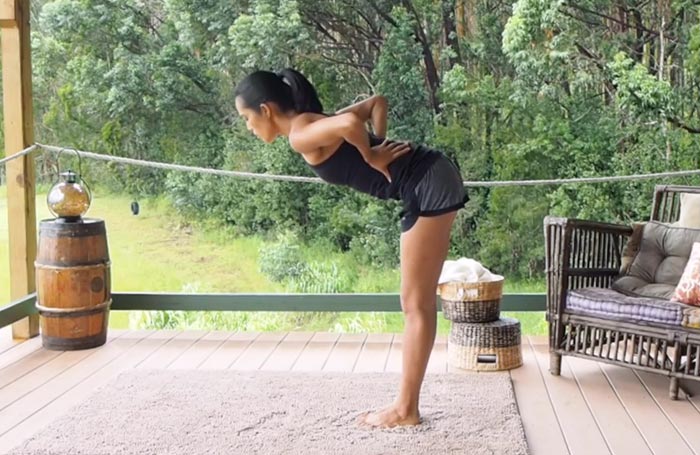
Click here to see VIDEO of the specific exercise.
Forward bend
- Place hands at your lower back, to support your back. Try and keep your weight balanced between your feet. Keep your legs straight but not locked.
- Keeping your back straight, move to lift your torso out of your hips and bend forward at the waist. Bend as far as you can go. Once you feel tension, stop and hold the pose.
- Breathe deep and make sure you “feel” the pose. Inhale as you extend back up, bringing your arms down. Exhale as you come down. Make sure you back is straight.
- Focus on bringing belly button to the tops of the thigh rather than bringing your forehead to your knees. When you pull with the belly button to the thighs, it allows your upper back to stay nice and straight.
- When you get to a place where you have reached complete tension or maximum flexibility then you can drop your head and relax it. You can deepen the pose by placing both hands behind thighs or calves and applying gentle pressure to pull your torso towards your legs. Breathe deeply while holding the pose.
- From forward bend, you can step into the next pose:
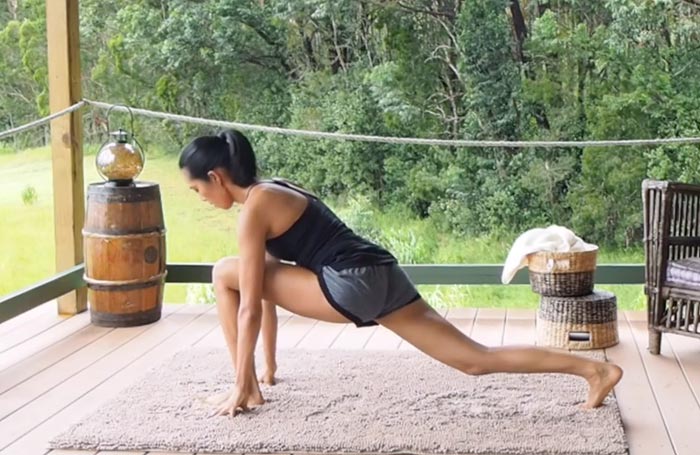
Click here to see VIDEO of the specific exercise.
Back lunge
- Place your hands on the ground on either side of your feet. Take a step back with one foot. From this position press your hips down into the ground and maintain a 90-degree angle on your front knee bend.
- If this is too difficult then drop one knee to the ground. Keep the top of your foot down against the ground. This will allow you to focus on balancing.
- Raise your arms up and open your chest-focus on grounding your hips down.
- From this position you can do twists which opens up your chest, shoulders and spine and is a great stress reliever.
This is also a great pose to link standing poses with ground poses.
From here place 2 hands on the ground and you will find yourself in the next pose
Tabletop pose
Tabletop is a great starting point for cat and cow poses.
Cow pose
Drop your belly to the ground, arch your head up and inhale.
For cat pose
You want to exhale while arching your back and pushing away from the ground. This pose is a great “massage” for your internal organs. It is also good for pelvic muscles and constipation.
From cat pose open your hips up and sit back into the next pose
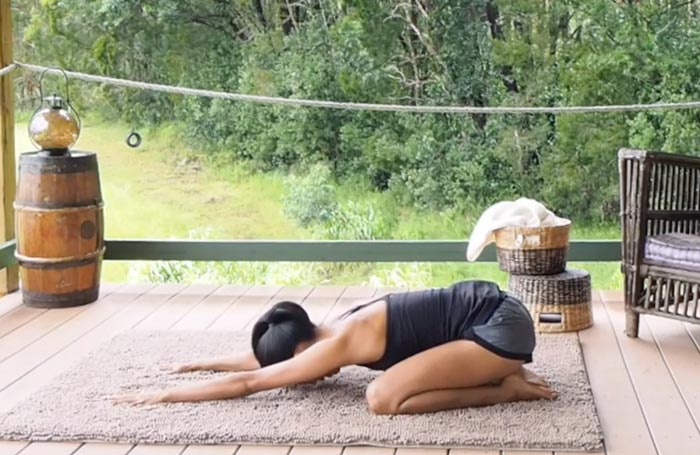
Click here to see VIDEO of the specific exercise.
Childs pose
If Childs pose is too difficult without support, you can add a towel or yoga block underneath your hips.
- In child’s pose you want to sit back on your hindquarters as far as you can and press your hands into the floor.
- Bring your shoulder blades down as you continue to press into the floor.
- Then inhale as you come back into tabletop pose.
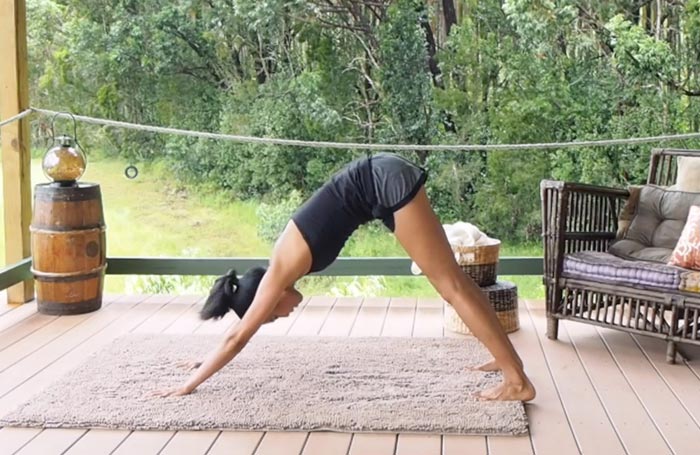
Click here to see VIDEO of the specific exercise.
Downward dog.
- Starting out in tabletop pose you want to extend into a plank, while maintaining a nice straight posture.
- Your feet should be about shoulder width apart and you are going to exhale as you pull your hips up toward the sky and push your upper torso away from the ground. You should be forming a “V” shape. Once in a V, press your heels into the ground, extending your legs and lifting your hips up.
- Relax your head in a neutral position and continue to press away from the ground as you pull your hips up and push your heels deeply into the ground.
- Inhaling out of downward dog back into plank. From Plank you can drop your hips into the next movement
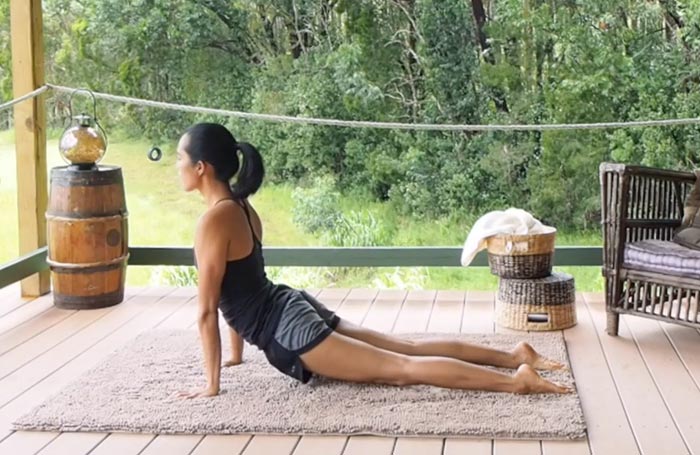
Click here to see VIDEO of the specific exercise.
Upward dog
- Position your feet so that the tops of them are on the ground.
- You should try and press your hips into the floor.
- You want to make sure your hips are down, shoulders are back and you are standing nice and tall in a neutral position –with a straight back.
- You should feel a nice compression in your lower back.
- From upward dog, you can work the flow backwards. Simply reverse the movement order.
Below is the whole exercise video
These movements are great to learn the foundation of yoga as well as building a strong core, which will help for more than just yoga. This routine can help with warmup, stretching and flexibility. The movements also all flow together from one to another movement.
If you are looking to build that strong functional core—either for general performance or to get better at sports or yoga—we are sure this routine will work well for you.
Add these moves to your yoga routine at least 2 times a week. In a month, you should notice better stability and reduced back pain. If you stick with it longer the performance gains should come as well.
Building a stronger core should be a goal of most people. More than just about looks, a strong core can help reduce chronic pain and injuries. A strong core also helps with sports and makes everyday tasks easier to do.
(1) http://www.pilates-place.co/upload/Stabilizing%20the%20Confusion.pdf and http://journals.lww.com/nsca-scj/Abstract/2007/04000/Core_Training__Stabilizing_the_Confusion.1.aspx
(2) http://www.ncbi.nlm.nih.gov/pmc/articles/PMC3737939/
(3)http://www.researchgate.net/publication/23489963_Optimizing_performance_by_improving_core_stability_and_core_strength

Leave a Reply
You must be logged in to post a comment.